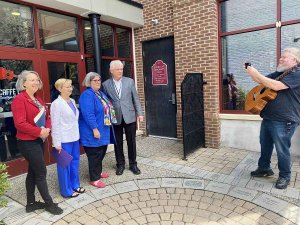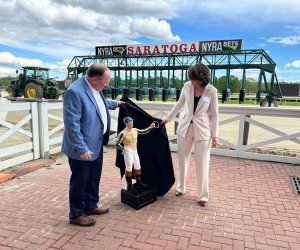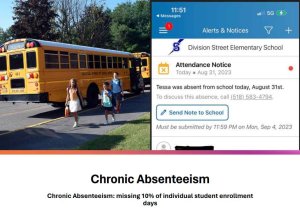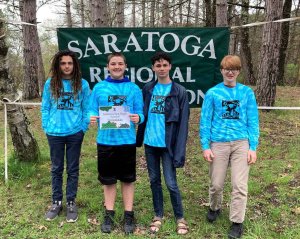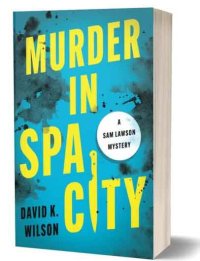Around 1800 Philip and Catharine Brotherson came into Blue Corners on the western edge of Charlton in Saratoga County. Over the next 40 years, their five children grew to maturity, the last being Benjamin Kissam Brotherson, born in 1819. At the age of sixteen, Benjamin was hired as a clerk for the dry goods merchant James Winne in Albany. During his time in Albany, he was known as an upstanding young man of good moral character. Only three years later, in 1838, he left his position in Albany and moved to New York City. Once in the city, he was hired by Union Bank, an institution that would be his employer for the next 20 years.
Over time the bank managers came to have the utmost confidence in this young man and gradually moved him into roles of greater responsibility. This confidence was not diminished when they found him often sought out to pay back small personal debts that he always seemed to be accumulating. Benjamin lived what outwardly was a frugal life, even living in a boarding house in the area that is now Greenwich Village.
In 1855, now 36 years old and with years of steady employment under his belt, Benjamin must have finally felt ready to take a wife. That August he married 25-year-old Anna Frances Robinson. Two years later Anna gave birth to a daughter, whom they named Adrian Francis. Unbeknownst to anyone but Benjamin and his wife, for over ten years he had been stealing tens of thousands of dollars from the bank and hiding the theft through false entries in the ledgers he kept as a head teller.
It was only through the curiosity of a New York City detective by the name of Joseph Keefe that questions were raised ultimately revealing Benjamin’s theft. While visiting Blakeman’s gambling house, Detective Keefe noticed the bank employee playing and losing large sums at a faro table. Bolstered by his suspicions, he kept watch over several weeks as Benjamin, who was known there as “Bob of the Union Bank,” bet and lost tens of thousands of dollars at various games of chance. After careful consideration, he approached the bank president with this discovery. The news was first met with disbelief that a long-time and highly trusted employee was involved in such questionable behavior. After a few days of deliberation within the bank leadership, it was decided to closely observe their employee for anything that would point to his dishonesty.
The increased scrutiny was quickly observed by Brotherson and complaining of a toothache, he left for lunch early and never returned. An examination of his books revealed that over the previous ten years he had taken as much as $140,000 from the bank. Soon after a warrant for his arrest was issued; it was reported that he had left the city on a ship headed to Panama in Central America. When questioned, his wife Anna was very cooperative with investigators, even freely giving evidence of her husband’s guilt that was published in the Auburn Weekly American on March 17, 1858: Brotherson’s wife converses freely regarding it, and stated to the lawyer who called upon her, that some years ago, previous to her marriage, B. told her that there was a defalcation in the Union Bank of $100,000, and asked her if she would marry him, knowing this fact. She consented and has faithfully kept his secret, but she says that it has worried him night and day and that he has repeatedly resolved to make a confession to the President but could not make sufficient courage. She says that B. asked for his pistol when he left, but seeing his excitement, she refused to let him have it, and he went away without it, telling her that she would not see him again for many years.
The investigation into Benjamin’s actions led the bank to Benjamin’s friend, Jacob Mott, a wealthy Wall Street stock trader. The scheme used by the two in removing the funds from the bank was quickly revealed and reported in the March 18, 1858, edition of the Litchfield Enquirer: Mr. Mott would make his deposits with the Receiving Teller; the Teller’s minutes were handed to Mr. Brotherson, who, instead of recording them correctly, would enter to Mr. Mott’s credit perhaps twice that sum, and Mr. Mott drew his checks upon the Bank accordingly. The money taken with the help of Mott was only part of what had been removed over the ten years that the thefts had been taking place, as Jacob Mott had opened an account at the bank only two years before the discovery. Surprisingly, after the initial reports of the theft and arrest of Mott, the matter seemed to have been dropped with no reports of the outcome in the weeks that followed.
At first, the bank announced that they would not pursue Brotherson, citing the reality that the funds had already been spent on gambling and he would have no means of making restitution. However, they quickly changed their mind and on March 24 of 1858, the bank announced a one-thousand-dollar reward for his apprehension. This reward was never paid out.
After Benjamin’s disappearance, his wife Anna went back to her maiden name, Robinson for both her and their daughter Adrian. In 1870 the two were living in a boarding house at 20 East 14th Street near 5th Avenue in New York City.
Where Benjamin fled is unknown, and his whereabouts for the next twenty years is a mystery. When Benjamin Kissam Brotherson surfaces for the last time he is beyond the reach of any penalty for his crime. On November 28, 1878, his brother John reported his death in the Saratoga Sentinel. Benjamin had died a few weeks earlier in Santa Barbara, CA, a place that John said Benjamin had gone two years before due to poor health.
Yet maybe there is a clue of his whereabouts for at least some of these years. In the early morning on Tuesday, May 3, 1870, a robbery was attempted at the First National Bank of Ballston Spa. The noise of the break-in was noticed almost immediately by those close by, as well as by a Mr. Brotherson, who according to a newspaper report “sleeps in the bank building, fired a gun twice and the village was alarmed.” Could this have been Benjamin, back in Saratoga County, hiding in plain sight all these years, and who, when finally, “found out” felt forced to move to the west coast?
Dave Waite is a resident of Blue Corners, Saratoga County and is a photographer and videographer. He has written many articles on upstate New York history, including several in the recently published book, More Saratoga County Stories. Dave can be reached at This email address is being protected from spambots. You need JavaScript enabled to view it.




